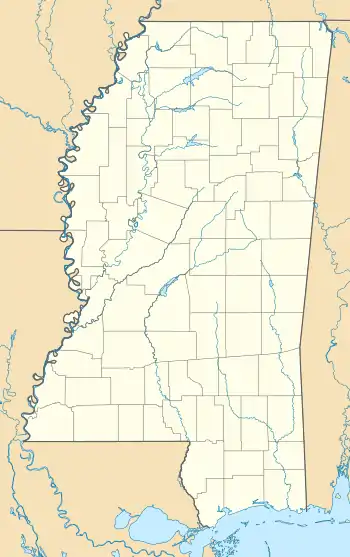Vicksburg National Military Park
Vicksburg National Military Park preserves the site of the American Civil War Battle of Vicksburg, waged from March 29 to July 4, 1863. The park, located in Vicksburg, Mississippi (flanking the Mississippi River), also commemorates the greater Vicksburg Campaign which led up to the battle. Reconstructed forts and trenches evoke memories of the 47-day siege that ended in the surrender of the city. Victory here and at Port Hudson, farther south in Louisiana, gave the Union control of the Mississippi River.
Vicksburg National Military Park | |
 The Illinois State Memorial in Vicksburg National Military Park. The structure was modeled after Rome's Temple of Minerva Medica and the Pantheon. The memorial was dedicated on October 26, 1906. | |
  | |
| Location | Vicksburg, Mississippi & Delta, Louisiana, USA |
|---|---|
| Coordinates | 32°20′38″N 90°51′5″W |
| Area | 1,852.75 acres (749.78 ha) |
| Built | February 21, 1899 |
| Architectural style | Greek Revival |
| Visitation | 532,444 (2015) |
| Website | Vicksburg National Military Park |
| NRHP reference No. | 66000100 |
| Added to NRHP | October 15, 1966 |
Battlefield
.jpg.webp)

The park includes 1,325 historic monuments and markers, 20 miles (32 km) of historic trenches and earthworks, a 16-mile (26 km) tour road, a 12.5-mile (20.1 km) walking trail, two antebellum homes, 144 emplaced cannons, the restored gunboat USS Cairo (sunk on December 12, 1862, on the Yazoo River), and the Grant's Canal site, where the Union Army attempted to build a canal to let their ships bypass Confederate artillery fire.
The Cairo, also known as the "Hardluck Ironclad," was the first U.S. ship in history to be sunk by a torpedo/mine. It was recovered from the Yazoo in 1964.
The Illinois State Memorial has 47 steps, one for every day Vicksburg was besieged.
Campaign against Vicksburg
- Battle of Chickasaw Bayou
- Battle of Arkansas Post
- Battle of Grand Gulf (April 29, 1863)
- Battle of Snyder's Bluff (April 29 – May 1)
- Battle of Port Gibson (May 1)
- Battle of Raymond (May 12)
- Battle of Jackson (May 14)
- Battle of Champion Hill (May 16)
- Battle of Big Black River Bridge (May 17)
- Siege of Vicksburg (May 18 – July 4)
Cemetery
The 116.28-acre (0.4706 km2) Vicksburg National Cemetery, is within the park. It has 18,244 interments (12,954 unidentified).
The time period for Civil War interments was 1866 to 1874. The cemetery is not open to new interments. The cemetery[1] has only one airman of Royal Australian Air Force buried during World War II.[2]
Grant's Canal
The remnants of Grant's Canal, a detached section of the military park, are located across from Vicksburg near Delta, Louisiana. Union Army Major General Ulysses S. Grant ordered the project, started on June 27, 1862, as part of his Vicksburg Campaign, with two goals in mind. The first was to alter the course of the Mississippi River in order to bypass the Confederate guns at Vicksburg. For various technical reasons the project failed to meet this goal. The river did change course by itself on April 26, 1876. The project met its second goal, keeping troops occupied during the laborious maneuvering required to begin the Battle of Vicksburg.
Administrative history
The national military park was established on February 21, 1899, to commemorate the siege and defense of Vicksburg. The park sprawls over 1,800 acres (7.3 km2) of land. The park and cemetery were transferred from the War Department to the National Park Service (NPS) on August 10, 1933. Of the park's 1,736.47 acres (not including the cemetery), 1,729.63 acres (6.9996 km2) are federally owned.
In the late 1950s, a portion of the park was transferred to the city as a local park in exchange for closing local roads running through the remainder of the park. It also allowed for the construction of Interstate 20. The monuments in land transferred to the city are still maintained by the NPS. As with all historic areas administered by the NPS, the park was listed on the National Register of Historic Places on October 15, 1966. Over half a million visitors visit the park every year.[3]
See also
References
- CWGC: Vicksburg National Cemetery
- CWGC: Edgar Horace Hawter
- "Annual Park Recreation Visitation (1904-Last Calendar Year)". Retrieved 6 November 2014.
- The National Parks: Index 2001-2003. Washington: U.S. Department of the Interior.
- Cell Phone Audio Tour of Vicksburg 601-262-2100
External links
| Wikimedia Commons has media related to Vicksburg National Military Park. |
- Official NPS website: Vicksburg National Military Park
- Main park map links: 32°20′39″N 90°51′6″W
- Grant's Canal map links: 32°19′14″N 90°56′0″W
- Vicksburg National Military Park, National Park Service at Google Cultural Institute